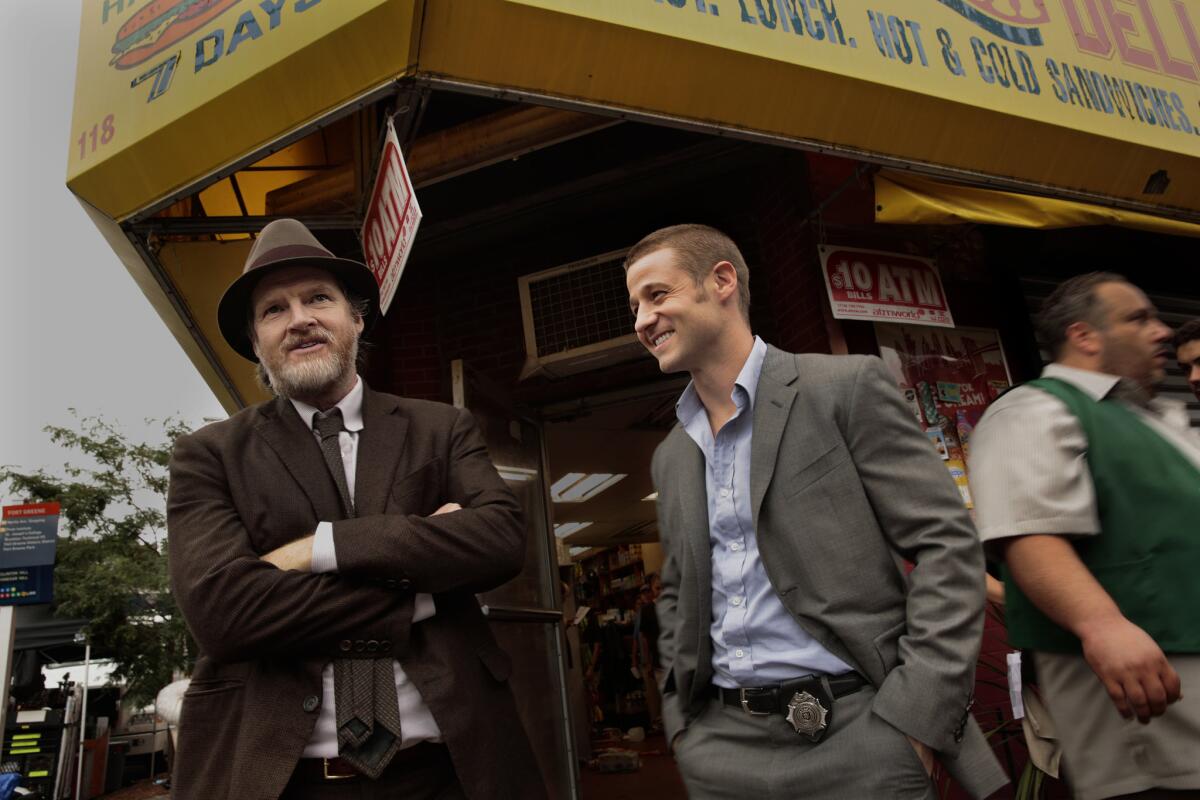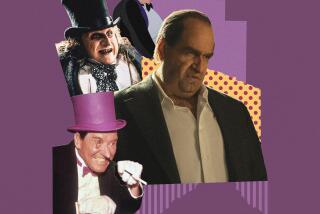TV Preview: ‘Gotham’: Before the Caped Crusader arrived on the scene

Reporting from NEW YORK — On a drizzly afternoon in August, a leafy block in brownstone Brooklyn has been transformed into Gotham City with surprisingly little effort — a fog machine and a few black vintage sedans are all it takes to turn this corner of stylish Fort Greene into Batman’s mythical hometown. (The gloomy weather adds a bit of free production value.)
In the episode being filmed, a dangerous, meth-like drug is taking over the streets of Gotham City, and detectives James Gordon and Harvey Bullock, played by Ben McKenzie, formerly of “The O.C.” and “Southland,” and Donal Logue, one of television’s most prolific character actors, are responding to a bodega robbery that seems linked to the dangerous substance.
Unfortunately, the Caped Crusader won’t be swooping in to help them any time soon. That’s because he’s still a 12-year-old boy known as Bruce Wayne. “Gotham,” which makes its premiere Sept. 22 on Fox, tells the origin stories of Batman, his ally Commissioner Gordon and many of their future nemeses, including the Riddler, the Penguin and Catwoman.
TV preview 2014: Full coverage
In a trend that has dominated the multiplex for the last decade and is now migrating to the small screen, comic book properties will be all over network TV this fall. “Gotham” may be the most high-profile example, but the CW also has “The Flash” (a spinoff of its established hit “The Arrow”) while NBC has “Constantine,” adapted from DC Comics’ “Hellblazer” series. These new shows join ABC’s “Marvel’s Agents of S.H.I.E.L.D.,” which premiered to strong ratings last year but saw its numbers slip dramatically over the course of the season.
Like that Joss Whedon series, “Gotham” faces the very specific challenge of being a superhero drama without an actual superhero at its center. Instead, it follows James Gordon, a rookie detective with the Gotham City Police Department assigned to investigate the murders of billionaires Thomas and Martha Wayne, parents to Bruce (David Mazouz). Together with partner Harvey Bullock, a grizzled and morally compromised veteran of the force, Gordon explores the criminal underbelly of a city sliding into chaos.
The project originated in conversations between writer and executive producer Bruno Heller, who created “Rome” and “The Mentalist” and has a deal with Warner Bros. Television, and Geoff Johns, chief creative officer at the Warner Bros. subsidiary DC Comics. “In all those talks, I could never quite see how I could do a superhero drama on network TV,” Heller says via telephone from Los Angeles. “TV is about human beings.” Then his son cracked the case, proposing a show built around a young Commissioner Gordon.
Last September, Fox won a heated bidding war for “Gotham,” making a series commitment before a pilot had been produced or a script written. While the failure of other straight-to-series orders like “The Michael J. Fox Show” provides a cautionary tale in the danger of industry hype outweighing audience interest, the chatter surrounding “Gotham” continues to be strong. In a deal announced earlier this month, Netflix will pay Warner Bros. a reported $1.75 million an episode for exclusive streaming rights to the series.
With “Gotham,” Fox also continues to push back against the standard 22-episode season, so far ordering 16 installments. Last season, the network had just 13 episodes of its biggest new hit, “Sleepy Hollow,” on hand and took a major ratings hit as a result, but Chief Operating Officer Joe Earley defends the less-is-more approach. “Shows as big as ‘Sleepy Hollow’ or ‘Gotham’ are like making a little movie every week,” he says, adding that the network may “reassess” its order later in the season.
Also like “Sleepy Hollow,” “Gotham” is a crime procedural folded within a fantastical serialized narrative (Logue jokingly refers to it as “Law & Order: Gotham”). This hybrid approach is designed to make “Gotham” appealing to fanboys while providing an easy entry for those less acquainted with Batman lore.
What some might see as a huge handicap — i.e., a Batman show minus Batman — Earley considers a liberating creative opportunity. “If you’re dealing with a preexisting intellectual property, then you have a really tricky relationship with the fans. But when you can chart the course without ostracizing people who already know every step of the way, it’s really exciting.”
Likewise, Heller thinks he has an advantage in approaching the world of “Gotham” as an admirer rather than a full-fledged fanboy. “To do the show that we’re doing, it was important to have someone running it who has the perspective of the general audience as well. The danger of being too deep into the universe is you’re only addressing the connoisseurs.”
In this regard, “Rome,” which portrayed figures such as Julius Caesar and Cleopatra, provided a useful lesson in not being overly precious about source material, no matter how familiar or revered it might be. After all, he notes, “I was dealing with characters Shakespeare’s done.”
Heller also understands the powerful appeal of the Batman mythology. “No one can hope they will be bit by a radioactive spider like Spider-Man, nor can you hope that you are in fact from another planet like Superman, but Batman becomes Batman by force of his own will. Everyone has a story of injustice that they would like to have avenged. Batman is a grand wish fulfillment of that.”
Another reason for Batman’s continued hold on the popular imagination, according to Heller, is that Gotham City represents “a kind of default dream world,” one that’s open to seemingly endless interpretations. His version falls on the spectrum somewhere between Tim Burton’s stylized film noir and Christopher Nolan’s moody realism. Heller and Danny Cannon, executive producer and director of the series pilot, drew inspiration from 1970s New York to create what Logue describes as “a representation of the urban American id.”
The villains are an essential part of this dystopian vision. An early contender for “Gotham’s” most enjoyable baddy is Oswald Cobblepot, whose transformation into the Penguin begins in the pilot episode. Played by relative unknown Robin Lord Taylor — you may recognize him from his role as zombie bait last season on “The Walking Dead” — Oswald is a low-level henchman for gangster Fish Mooney (Jada Pinkett Smith), a character invented for the series.
“He does some very despicable things, but at the same time it’s very clear why he’s doing them,” Taylor says of his character. “It’s not like he’s going out and murdering kittens. He was bullied and ridiculed, and he just refuses to go back to that place where he’s powerless and weak.”
Of the cast, McKenzie may have the toughest job of all playing what he calls an “old-school hero” (one who’s already been portrayed by the likes of Gary Oldman) in a world populated by wickedly entertaining villains. “One of the challenges is just to make sure he doesn’t come across as too much of either a rube or a goody-two-shoes or dull,” says the actor.
The same restrictions apply to “Gotham” itself, a network drama airing at the family-friendly hour of 8 p.m. But just because the series can’t get as grim or as violent as cable fare doesn’t mean it lacks an edge, says Heller: “It’s a dark world, but it’s a dark world with hope.”
More to Read
The complete guide to home viewing
Get Screen Gab for everything about the TV shows and streaming movies everyone’s talking about.
You may occasionally receive promotional content from the Los Angeles Times.






